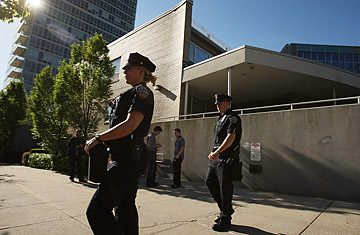
Police stand guard outside of Riverdale Jewish Center following the apparent foiling of a terrorist plot on May 21, 2009, in New York City
It will be days, possibly weeks, before we know all the details of how the attempted Riverdale bombing was foiled, but counterterrorism experts say it's already clear where the plotters made their first mistake: they picked targets in New York City. Since the devastating attacks on Sept. 11, the city has built up formidable intelligence resources that are designed to anticipate, detect and eliminate terrorism threats. "No city is better prepared for this kind of attack than New York," says Fred Burton, a counterterrorism expert at Stratfor, a global-intelligence firm. "These guys picked the wrong town to mess with."
Between the NYPD's counterterrorism bureau, the FBI-led Joint Terrorism Task Force and a U.S. Attorney's office vastly experienced in national-security issues, "you have a perfect storm of anti-terror efforts in New York, and [the plotters] ran straight into it," Burton says. The city, along with Los Angeles, "has resources comparable to many countries," says James Carafano, a terrorism analyst at the Heritage Foundation. (See pictures of a jihadist's journey.)
Law-enforcement officials have not said how exactly they came to know of the plot or how the FBI informant came into contact with the plotters. But experts say New York authorities have developed an extensive network of community contacts to keep tabs on suspicious behavior. Burton surmises that authorities had a tip-off that the mosque used by chief plotter James Cromitie "was conducive to the radicalization process" and planted an informant among the congregation — which ultimately led the authorities to Cromitie.
At that point, experts say, officials in most U.S. cities would have arrested Cromitie and his fellow conspirators. But because of New York's superior resources, authorities were able to take more time — months, as it turns out — using intensive surveillance to map out the full details of the plot and to see if the plotters had connections to other domestic or international groups. "In the U.S. we tend to roll up the conspirators quickly, but in the U.K. they allow the conspiracies to run a long way, so they can scoop up as much more intelligence," says Bill Rosenau, a national-security expert at the Rand Corp. "What you saw in New York was very much like a U.K. operation."
Longer surveillance also helps authorities to build a stronger legal case against the plotters, the better to secure convictions and longer sentences. "If you get them after they have planted the bombs, you're likely to send them away for longer jail terms than for just the possession [of bombs]," says Rosenau.
As good as the New York counterterrorism infrastructure is, it may have been helped by luck. It's impossible to know how far Cromitie might have gone if he had not reached out to the FBI informant. "Terrorist plots are most vulnerable when the terrorists have to go outside their group for help," says Burton. Lacking the "terrorism tradecraft" to build explosives themselves, the plotters had no choice but to seek help, and "that greatly increased the chances they would be caught," he adds.
Although Cromitie and company don't seem to have had any contact with more highly skilled international terrorism groups, that should not diminish the seriousness of the plot, says Carafano. "Oftentimes, it's the amateurs who are more likely to do harm — people who are more lucky than good," he says. "Timothy McVeigh didn't train in an al-Qaeda camp, after all."
Carafano says those looking for similarities between the Newburgh 4 and other failed plotters won't get very far. Heritage lists Newburgh as the 22nd known plot since Sept. 11, "and so far, the pattern is that there's no pattern," he says. Some plotters went to terrorism camps, others were "self-radicalized"; some hooked up through mosques, others through the Internet.
Rosenau, however, says there are parallels with some other plotters — particularly the group nabbed in Los Angeles in 2005 for planning attacks on Army recruitment centers and synagogues. There are similarities, too, with the 2007 Fort Dix terrorism plot. "These were mostly U.S. citizens who had turned into terrorists," he says. "And some of their targets were similar."
As more details emerge about the plot, experts will be watching carefully for new patterns. But if other would-be plotters are watching, they may conclude that New York is best left alone.
